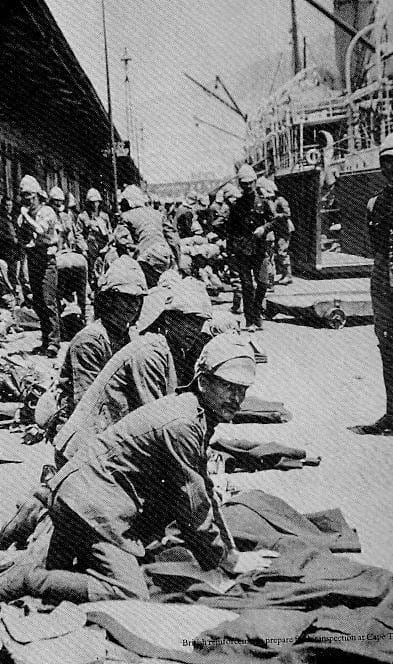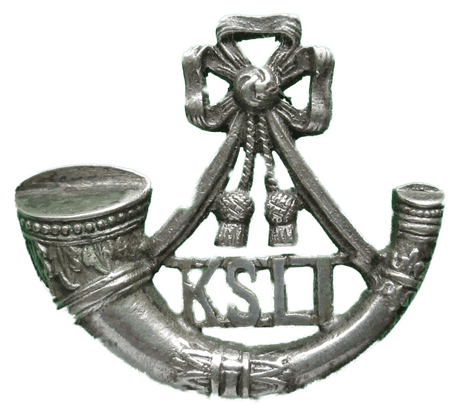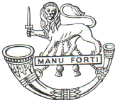
The Second BOER War
Volunteer Service Companies - KSLI
1899 - 1902
The Volunteer Service Companies of the 2nd Battalion King's Shropshire Light Infantry
A shortage of Regular troops to fight in South Africa resulted in calls being made in the UK to the auxiliary formations (Yeomanry, Militia and Rifles Volunteers) to send reinforcements. In the case of the Rifle Volunteers, Volunteer Service Companies (VSC) of 3 + 113 were to be formed and were to serve as a formed company, attached to a regular unit, for 12 months in South Africa. 1st and 2nd Volunteer Battalions KSLI and the Herefordshire RVC (Hereford & Radnor), being the three volunteer battalions of 53rd Regimental District, each provided a detachment for the VSC KSLI, which was formed at the depot of the KSLI, Copthorne Barracks, Shrewsbury, in 1900.
The conditions under which the services of members of the Volunteer Force were accepted for duty in South Africa were set forth in an Army Order issued by Lord Wolseley, Commander-in-Chief:
A carefully selected Company of 116 of all ranks may be raised for each line Battalion serving in or about to proceed to South Africa from the affiliated Volunteer Battalions. This Company will be attached for service to the line Battalion in South Africa and placed under the Commanding Officer of that Battalion.
An equal number of waiting Companies may be maintained at home.
The 5th (Irish) Volunteer Battalion, Liverpool Regiment, will furnish the Company for the Royal Irish Regiment, and the 16th Middlesex (London Irish) for the Royal Irish Rifles.
The strength of each Company will be one Captain, two Subalterns, one Sergeant-Instructor to act as Pay Sergeant, four Sergeants, two Buglers, five Corporals, ninety-nine Privates and two Stretcher Bearers. Total: 116.
The selection of Officers and the composition of each Company will be controlled by the Officer Commanding the Regimental District in which it is raised. In the case of line Battalions having several affiliated Volunteer Battalions, Companies will be formed from about an equal number of men from each Battalion, as the Officer Commanding the Regimental District may decide. No Volunteer Battalion will be allowed to contribute less than one complete section.
The following will be the qualifications for service:
• Every Volunteer must enlist for one year, or for the War. In the event of the War being over in less than one year he will have the option of being discharged at once or of completing his one year's service. •
• He must be not less than twenty nor more than thirty-five years of age. •
• He must be a first class shot under volunteer rules. •
• He must have been returned as efficient during 1898 and 1899. •
• He must be of good character. •
• He must be up to the physical standard of an Infantry recruit as laid down in the Recruiting Regulations for the Army. No relaxation of standard will be allowed.
• He must be medically fit for active service.
• Preference should be given to unmarried men or widowers without children. Married men should be accepted only in the event of an insufficient number of single men or widowers without children volunteering.
When a Volunteer Commanding Officer has received application from not less than a Section of Volunteers, he will so inform the Officer Commanding the Regimental Depot to which his Battalion is affiliated, who will then — if they are to form part of the Service Company — have them medically inspected and, if fit for service, attested.
After attestation they will join the Regimental Depot until required for embarkation. In the event of there not being sufficien
In 1900 1st HRVC took part in the 28 day emergency camp at Fleetwood, Lancashire, and detachments from the battalion formed part of 1st and 2nd Volunteer Service Companies KSLI, which served with 2nd (Regular) Battalion KSLI in South Africa during the years 1900 to 1902. 2nd Battalion KSLI formed part of 19 Brigade of 9 Division.
The numbers volunteering for these detachments far exceeded the requirement, and this enthusiasm was indicative of the fighting spirit of the Battalion. The first detachment was under the command of Lt JF Cutler, and the second detachment Lt Percy Anthony.
The restriction on numbers accepted for active service with the VSCs caused some disappointment, and two officers of 1st HVRC offered their services individually: Maj JRL Rankin served with Rimington's Guides and Capt E Kenworthy with Roberts' Horse, two of the irregular units raised in South Africa during the war. Maj Rankin was the author of the well known history of Rimington's Guides: A Subaltern's Letters to His Wife. It is of interest that the adjutant of the Guides was Capt CH Rankin of the 7th Hussars. The unit, commonly known as Rimington's Tigers' from the piece of leopard skin worn around the slouch hat, became famous when one of its patrols discovered the main Boer Force under Cronje on the western border of the Free State. This discovery led to the capture of Cronje's force at Paardeberg on 27 February 1900, one of the first successes of the war, and one of the proudest Battle Honours of the KSLI.
The Bearer Company was also eager to render help in the urgent demand for stretcher-bearers, and a number of volunteers from the Welsh Border Bearer Company RAMC served in the South African War.


